World Money Show London, November 2014
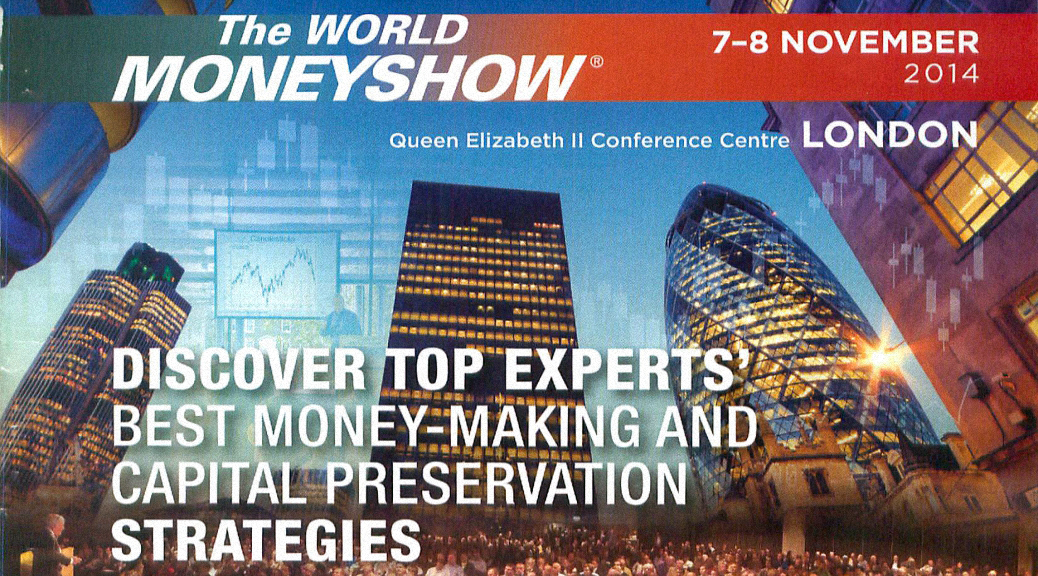
A couple of weeks ago I made it over to the Queen Elizabeth II conference centre opposite Parliament, for the annual World Money Show London. It’s a two-day event which I’ve been to before, but this year I could only be there on the Friday.
Even so, I managed to see eight speakers, the usual mix of experienced characters and salesmen. All were at least decent presenters; it would be nice just once to hear from a tongue-tied market boffin.
One thing that felt different about this year’s show was the increased number of American speakers. In part this was because some of the better UK speakers from two years ago had decided to monetise their talks behind paywalls (as usual, I didn’t pay for my ticket and only attended free sessions).
Contents
- Mark Mobius, Franklin Templeton – Emerging markets outlook
- Jim Jubak, Moneyshow – Impact of a strong dollar
- John Bollinger – Trading bands: past, present and future
- Ralph Acampora – Technical view of 2014-15
- Jason Stapleton, Trade Empowered
- Jimmy Young, Wealth Training Company
- Bill Morrow, Angel’s Den
- Mark Rogers, Motley Fool
Mark Mobius, Franklin Templeton – Emerging markets outlook
First up was Mark Mobius of Franklin Templeton who I’ve followed since the 1980s. Unfortunately it was only a teleconference from Hong Kong, and one with some dodgy sound and out-of-sync slide turning to boot.
Mark gave a positive presentation on the potential within emerging markets, rattling off an impressive series of statistics. He began with higher growth rates, especially in per-capita GDP. ((It must be said there is research to show that high GDP growth often does not translate into high stock market growth.)) Seventy percent of smartphone sales are now in emerging markets, and there are 800 million mobile-only internet users.
FX reserves are increasing in emerging markets, debt is decreasing and credit ratings are improving. The market index spread and yield spread vs. developed countries is now back to pre-crisis levels, with emerging markets having outperformed in 7 of the last 10 years.
There have been positive fund flows into the area every year since 1995 (barring 2008). Emerging markets now have more than their share of new issues (32% vs. 30% of global market cap), and are cheaper (p/e of 10 vs 15, p/b of 1.5 vs 2.2) than developed markets. Money velocity is declining as central bank assets increase – there is money waiting to be invested.
Mark then went on to focus on China in particular. New reforms are positive for the stock market, and there is a long way to go with infrastructure development (for example, railway density remains seven times lower than London and five times lower than Paris).
Growth has slowed in percentage terms (10% pa down to 7% pa) but in dollar terms it remains constant ($1000bn / year). Salaries are up, property sales and prices are up. Urbanisation has risen from 36% to 52% between 2000 and 2012 (cf. 80% in the US).
The flurry of facts was a good way to wake us up at 9am, and certainly felt reassuring at the time, but I have no plans to change my emerging markets allocation in the short-term – in either direction.
Jim Jubak, Moneyshow – Impact of a strong dollar
Jim Jubak works for MoneyShow and runs a stock-picking service. He gave a brief presentation on the impact of the dollar rising as the yen and the euro fell. One of the main impacts would be the high cost of oil for Japan and Europe relative to the US (since oil is priced in dollars). ((Although as I will discuss in another post, we could be in for low oil prices all round for the foreseeable future.))
Jim expects the Fed to raise interest rates before anyone else, probably in 2015. He also expects 3% growth in the US, compared to 1% growth (and 1% inflation) in Europe and Japan, who are both looking to export their way to growth.
The questions are whether the US can absorb all the exports, and whether cheap imports to the rest of the world will result in Japan and Europe exporting their low inflation / potential deflation.
Jim sees the main effects as being a lower oil price, lower gold price, and pressure on emerging market currencies, especially Brazil, Indonesia, Turkey and Russia. Unlike Japan, these countries are not self-funding and rely on high commodity prices to support their high amounts of dollar-denominated debt.
He pointed to the recent Chinese corporate bond default (the first ever) and expects more corporate bond defaults in emerging economies, where subsidies to the poor limit the freedom of governments to intervene.
John Bollinger – Trading bands: past, present and future
John Bollinger is the inventor of Bollinger Bands, one of my favourite technical indicators, and I was very much looking forward to his presentation. Unfortunately John had a paid-for (£149) session on the second day of the conference, and this engaging performance was really a puff piece for that. John really is a living legend, so much so that as he admitted, the first thing most people say to him is “I thought you were dead.”
He began with a history of trading bands. The original system he used was a pair of 4% bands above and below the 21-day MA of an index. As oscillators he used the 21-day advance/decline in prices, and the 21-day volume change. The rule was to sell if the index was above the upper band and either oscillator was below zero. Below the lower band, with either oscillator above zero, he would buy.
This worked for years, then stopped. Initially the bands were increased to 4.5% and this again worked for a few years and then stopped. John wanted to find a process to set the proper width for the bands, without using human emotion.
The first step to this was Bomar bands, which enclosed 85% of the data above and below the MA. At the time, these were very difficult to compute. John noticed that volatility was varying, in contrast to say beta, seen as a fixed property calculated once a year from the previous five years data. He used volatility to calculate the width of his own bands. John jokingly noted that Engle received the Nobel Prize thirty years later for proving that volatility is dynamic.
John thinks that nothing has changed in technical analysis (TA) for 20 years – all the recent interesting work has been in behavioural finance. He is currently revisiting old ideas in TA such as AI (eg, mycin and prospector) with today’s increased computing power.
Answering questions from the floor, John noted the recent rise in popularity of low volatility portfolios, and worries these will lead to a market crash in 2 or 5 or 10 years. He thinks that a lot of received wisdom (moving averages, buy and hold, market timing with eg. ETFs) doesn’t work.
He feels that the Euro has destroyed the futures of a generation and there will be much more pain before it finally dies. He likes FX charts, which show nice long-term trends with lots of short-term mean reversion that is tradeable.
Ralph Acampora – Technical view of 2014-15
Ralph Acampora is sometimes referred to as the Godfather of Technical Analysis. He is a very entertaining speaker (he used to have a TV show in the US) and was a great choice to send us out of the morning session buzzing.
Ralph founded the Market Technicians Association back in 1970, when I was more interested in moon landings than the markets. Now he worries that TA may be too popular, and that many of those using it don’t really know what they are talking about.
Ralph’s view is that we are in a secular bull market (as in 1982-2000) that might have another 10 to 15 years to go, from the 2009 low. He foresees cyclical bears within this run, but only lasting months. He compares todays low inflation, low interest rate conditions with the bull market of the 1960s.
Ralph described the typical bull market cycle: quality blue chips rise first then years later, the secondaries (in the US, think Procter & Gamble, then Colgate). In the last phase junk goes up and you get tips at parties (as in say 1999). The three phases are: disbelief & fear, belief & trust, complacency & greed. At the moment we are in phase two.
He is waiting for confirming new highs in the broad US market, the FTSE, the DAX and Dubai as long-term indicators, but the bull market remains in place for now. In the short-term, he expects the 3rd year of the presidency to be positive as usual, and expects gold to go down and oil to stick at around $70.
Jason Stapleton, Trade Empowered
Jason Stapleton is a Charlie Sheen lookalike / soundalike and ex-US Marine special ops dude. He got into trading during his close protection years in Iraq, where he had lots of money and lots of spare time. He fronts a company called Trade Empowered, which sells training courses in how to trade TA strategies. The USP is the military-style training which reinforces performance under pressure.
He began by comparing trading to weight loss – you only need to be right a bit more than you are wrong, The problem is that most people wouldn’t be right even with a proven profitable strategy. His company ignores fundamentals, seeing markets as 100% psychological – “it’s not the number, it’s the reaction to the number.” Price history tells the full story – who was buying and who was selling.
He explained how army training works: there is a preparatory command, which puts you into a state of readiness and then the action command (“right … face”). Similarly, his firm train students how to prepare for the combat situation of trading. He insists on trade plans (where you will get in, where you will get out) and repeatable behaviours.
The aim is to achieve “state” (flow, being in the zone etc), where actions become effortless (unconscious competence, like driving). This is trading as an extreme sport, with the trader an athlete. To use my own fitness analogy, this is CrossFit, not strength training.
Jimmy Young, Wealth Training Company
After four American presenters, we have our first English one. He’s billed in the agenda as multi-millionaire investor Jimmy Young, but in the back of the programme his speaker notes reveal that he is Darren Winters, who has a long track-record in selling trading training. ((I’m in no position to lecture about the use of pseudonyms, but I thought you should know.))
Jimmy / Darren is a very good evangelical sales presenter. I caught the show twice, in the lunchtime bullpen and an afternoon session. He was word-perfect without notes, and all the spontaneous pauses and laughs came in the same places. He ran through five pieces of trading theory. ((not necessarily profitable in practice))
- 9 chart patterns (three for reversal, three for continuation, three for consolidation) ((we’ll look at patterns when we come to technical analysis for trading))
- sector rotation across a 5-stage economic cycle model ((sector rotation is something I am interested in, and will return to in a later post))
- channelling with 14-day ROC
- cut your losses, run you winners, using trailing stops
- use of risk-to-reward ratios (min 2-3) for choosing the best trades
His pitch is a teaser, offering some genuine material but pitching a 2-day course which starts at £2k but comes down in price as the presentation wears on. There is also a home study course (6 CDs and a book for £1K). At the end of the speech, you could buy 2 tickets to the course, plus the home study materials for £97, “saving” you £4,103. Only if you signed up right there and then, of course.
Bill Morrow, Angel’s Den
Bill Morrow is a Scottish accountant who has been running Europe’s largest network of angel investors for the past eight years. Bill’s session was not well-attended, and none of the twenty or so audience looked like business angels to me, though it emerged eventually that three of them were.
Bill suffered from a Powerpoint / laptop failure which meant that he had to speak for an hour without slides. It was a revealing and entertaining presentation on an area I didn’t know too much about.
Angels Den (AD) is run as a service to investors, not entrepreneurs. The offer a curated deal service (they receive 100 offers per day) through an international branch network. They only do equity deals (no debt). Bill described the current market as awash with cash, bringing bad businesses to market and leading to unrealistic valuations from sellers.
He drew a distinction between investors and angels. As well as money, angels have time and contacts. Bill’s investors aren’t looking at the numbers (valuations, cashflow etc). He finds that investors who have no active part in a business usually lose money.
Bill recommends a substantial investment as it concentrates the mind. The average investment through AD’s network of 2000 angels is £203K for 18% of a company (worth around £1.13M). Investments of this size are not material to £10M companies. AD attracts 130 new angels per month through free training on how angel investing works.
Only 6% of AD’s businesses have gone bust over eight years. Their main sectors are tech, music, food & drink and property (where less mentoring is usually needed).
Angels generally want to put 8-9% of their wealth into angel investments, often across 2 or 3 companies. Depending on how you look at these numbers, angels have average net worth of between £2.3M and £4.6M. They usual invest around 14 months after an “equity event” – taking profits from an earlier business. There is a parallel to be drawn here with recovery from bereavement, and the time taken by stock markets to recover from shocks.
The three top reasons for investing are:
- something to do / fun in retirement
- giving something back to younger people
- profits
AD have tested seventeen ways of pitching and have found that stand-up pitching doesn’t work. Their preferred method is speed investing – 8 pitches of 5 minutes each to 8 angels at a table, then drinks. Often five of the eight pitches will be funded.
Angels choose people they would like to work with over the best business and think they will get their money back in three years (they won’t). Women are more than twice as likely to be funded, and 92% of angels are men. Bill thinks that one reason is that women don’t ask for as much money.
As you might expect, Bill is no fan of crowdfunding, though he does often refer businesses he can’t support through AD to CrowdCube. These platforms just give money to entrepreneurs, and entrepreneurs don’t know best – lots of crowdfunded companies are now going bust.
Crowdfunding investments average £471 per investor, with 500+ investors per company. The nominee structures used are expensive and remove control from the investors. Valuations aren’t important for crowdfunding platforms as they make a cut of the funds raised. AD also make their money that way (5% cut of funds raised) as well as by charging £800 to each firm that pitches.
Angel investing isn’t really something I had though about (largely because I didn’t think I had enough money) but I might pop along to one of Bill’s masterclasses to be sure. As well as this, he gave me plenty to think about when considering investment in the immature but trendy crowdfunding arena.
Mark Rogers, Motley Fool
My final presentation of the day was from Mark Rogers of The Motley Fool (TMF) ((the name comes from the medieval concept that the Fool was the only person who could tell the truth to the King without fear of losing his head.)) I was a big fan of TMF and their refreshing approach when they emerged in the 1990s. I’ve been disappointed by the way they have declined into little more than a tips service, and this session would do nothing to change my opinion.
Mark began the presentation with a lot of traditional Fool wisdom:
- Don’t follow the crowd.
- Play to your strengths – the personal investor’s advantage is time and patience. You are your own boss with a long time horizon.
- Understand and avoid your weaknesses.
- Since the 1800s the chance of the market rising in real terms is 52% after 1 day, 80% after 5 years and 100% after 10-15 years.
- You must accept your own limitations and not take things to seriously. Sometimes this right answer is “I don’t know”.
- Cut out the noise: don’t listen to the news, or check your prices all the time.
- Don’t panic (in a market crash).
All good stuff, but then on to the product. TMF offer two flavours of stock tips: Fire (growth) and Ice (income). They focus on valuations, not prices, and expect good businesses to get better with time. Finally, the big reveal (to groans from the audience) – Sports Direct is the latest Fire tip.
And with that we were off to queue for our single free glass of red wine. ((courtesy of Mark Plummer, chairman of Chestnut Exploration, the US oil company sponsoring the show and looking for direct investment in US oil)) And after that, into the night in the search for a pint of bitter.

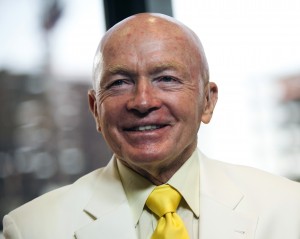


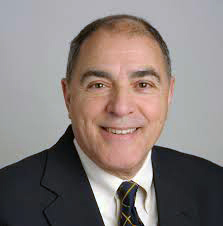

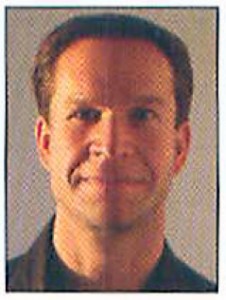
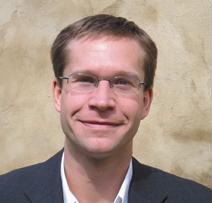
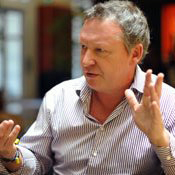

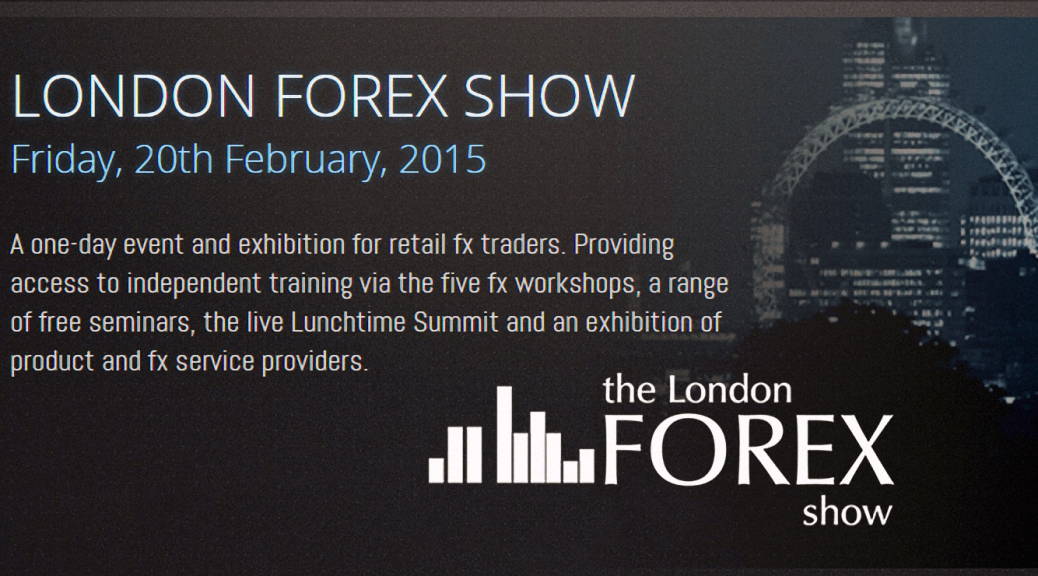
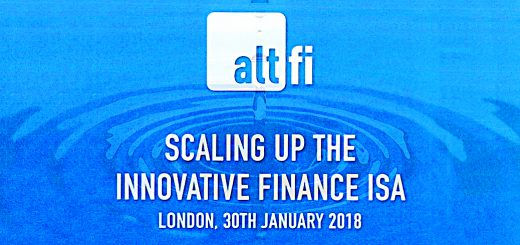












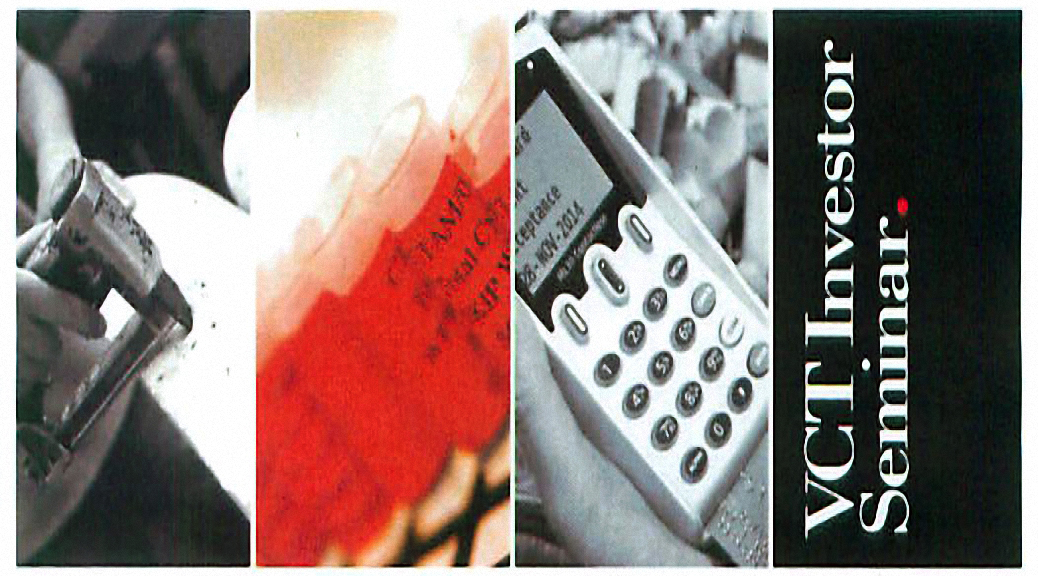

2 Responses
[…] at the World Money Show last month, I picked up a 73-page booklet from our friends at Stockpedia on US Stocks for UK […]
[…] first saw Darren’s presentation at the World Money Show in November 2014, and it hasn’t changed at all. I’m going to focus on the slide […]